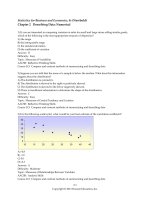Statistics for business economics 7th by paul newbold chapter 01
Bạn đang xem bản rút gọn của tài liệu. Xem và tải ngay bản đầy đủ của tài liệu tại đây (3.13 MB, 59 trang )
Statistics for
Business and Economics
7th Edition
Chapter 1
Describing Data: Graphical
Copyright © 2010 Pearson Education, Inc. Publishing as Prentice Hall
Ch. 1-1
Chapter Goals
After completing this chapter, you should be able to:
Explain how decisions are often based on incomplete
information
Explain key definitions:
♦
Population vs. Sample
♦ Parameter vs. Statistic
♦ Descriptive vs. Inferential Statistics
Describe random sampling
Explain the difference between Descriptive and
Inferential statistics
Identify types of data and levels of measurement
Copyright © 2010 Pearson Education, Inc. Publishing as Prentice Hall
Ch. 1-2
Chapter Goals
(continued)
After completing this chapter, you should be able to:
Create and interpret graphs to describe categorical
variables:
Create a line chart to describe time-series data
Create and interpret graphs to describe numerical
variables:
frequency distribution, histogram, ogive, stem-and-leaf display
Construct and interpret graphs to describe
relationships between variables:
frequency distribution, bar chart, pie chart, Pareto diagram
Scatter plot, cross table
Describe appropriate and inappropriate ways to
display data graphically
Copyright © 2010 Pearson Education, Inc. Publishing as Prentice Hall
Ch. 1-3
1.1
Dealing with Uncertainty
Everyday decisions are based on incomplete
information
Consider:
Will the job market be strong when I graduate?
Will the price of Yahoo stock be higher in six
months than it is now?
Will interest rates remain low for the rest of the year
if the federal budget deficit is as high as predicted?
Copyright © 2010 Pearson Education, Inc. Publishing as Prentice Hall
Ch. 1-4
Dealing with Uncertainty
(continued)
Numbers and data are used to assist decision making
Statistics is a tool to help process, summarize,
analyze, and interpret data
Copyright © 2010 Pearson Education, Inc. Publishing as Prentice Hall
Ch. 1-5
1.2
Key Definitions
A population is the collection of all items of interest
or under investigation
N represents the population size
A sample is an observed subset of the population
n represents the sample size
A parameter is a specific characteristic of a
population
A statistic is a specific characteristic of a sample
Copyright © 2010 Pearson Education, Inc. Publishing as Prentice Hall
Ch. 1-6
Population vs. Sample
Population
a b
Sample
cd
b
ef gh i jk l m n
o p q rs t u v w
x y
z
Values calculated using
population data are called
parameters
Copyright © 2010 Pearson Education, Inc. Publishing as Prentice Hall
c
gi
o
n
r
u
y
Values computed from
sample data are called
statistics
Ch. 1-7
Examples of Populations
Names of all registered voters in the United States
Incomes of all families living in Daytona Beach
Annual returns of all stocks traded on the New York
Stock Exchange
Grade point averages of all the students in your
university
Copyright © 2010 Pearson Education, Inc. Publishing as Prentice Hall
Ch. 1-8
Random Sampling
Simple random sampling is a procedure in which
each member of the population is chosen strictly by
chance,
each member of the population is equally likely to
be chosen,
every possible sample of n objects is equally likely
to be chosen
The resulting sample is called a random sample
Copyright © 2010 Pearson Education, Inc. Publishing as Prentice Hall
Ch. 1-9
Descriptive and Inferential Statistics
Two branches of statistics:
Descriptive statistics
Graphical and numerical procedures to summarize and process data
Inferential statistics
Using data to make predictions, forecasts, and estimates to assist decision making
Copyright © 2010 Pearson Education, Inc. Publishing as Prentice Hall
Ch. 1-10
Descriptive Statistics
Collect data
Present data
e.g., Survey
e.g., Tables and graphs
Summarize data
e.g., Sample mean =
Copyright © 2010 Pearson Education, Inc. Publishing as Prentice Hall
∑X
i
n
Ch. 1-11
Inferential Statistics
Estimation
e.g., Estimate the population
mean weight using the sample
mean weight
Hypothesis testing
e.g., Test the claim that the
population mean weight is 140
pounds
Inference is the process of drawing conclusions or
making decisions about a population based on
sample results
Copyright © 2010 Pearson Education, Inc. Publishing as Prentice Hall
Ch. 1-12
Types of Data
Data
Categorical
Numerical
Examples:
Marital Status
Are you registered to
vote?
Eye Color
(Defined categories or
groups)
Discrete
Examples:
Copyright © 2010 Pearson Education, Inc. Publishing as Prentice Hall
Number of Children
Defects per hour
(Counted items)
Continuous
Examples:
Weight
Voltage
(Measured characteristics)
Ch. 1-13
Measurement Levels
Differences between
measurements, true
zero exists
Ratio Data
Quantitative Data
Differences between
measurements but no
true zero
Ordered Categories
(rankings, order, or
scaling)
Interval Data
Ordinal Data
Qualitative Data
Categories (no
ordering or direction)
Nominal Data
Copyright © 2010 Pearson Education, Inc. Publishing as Prentice Hall
Ch. 1-14
Graphical
Presentation of Data
1.3
Data in raw form are usually not easy to use for
decision making
Some type of organization is needed
Table
Graph
The type of graph to use depends on the variable
being summarized
Copyright © 2010 Pearson Education, Inc. Publishing as Prentice Hall
Ch. 1-15
Graphical
Presentation of Data
(continued)
Techniques reviewed in this chapter:
Categorical
Variables
• Frequency distribution
• Bar chart
• Pie chart
• Pareto diagram
Copyright © 2010 Pearson Education, Inc. Publishing as Prentice Hall
Numerical
Variables
• Line chart
• Frequency distribution
• Histogram and ogive
• Stem-and-leaf display
• Scatter plot
Ch. 1-16
Tables and Graphs for
Categorical Variables
Categorical
Data
Tabulating Data
Frequency
Distribution
Table
Copyright © 2010 Pearson Education, Inc. Publishing as Prentice Hall
Graphing Data
Bar
Chart
Pie
Chart
Pareto
Diagram
Ch. 1-17
The Frequency
Distribution Table
Summarize data by category
Example: Hospital Patients by Unit
Hospital Unit
Cardiac Care
Emergency
Intensive Care
Maternity
Surgery
Number of Patients
1,052
2,245
340
552
4,630
(Variables are
categorical)
Copyright © 2010 Pearson Education, Inc. Publishing as Prentice Hall
Ch. 1-18
Bar and Pie Charts
Bar charts and Pie charts are often used for
qualitative (category) data
Height of bar or size of pie slice shows the
frequency or percentage for each category
Copyright © 2010 Pearson Education, Inc. Publishing as Prentice Hall
Ch. 1-19
Bar Chart Example
Hospital
Unit
Cardiac Care
Emergency
Intensive Care
Maternity
Surgery
Number
of Patients
1,052
2,245
340
552
4,630
Copyright © 2010 Pearson Education, Inc. Publishing as Prentice Hall
Ch. 1-20
Pie Chart Example
Hospital
Unit
Cardiac Care
Emergency
Intensive Care
Maternity
Surgery
Number
of Patients
% of
Total
1,052
2,245
340
552
4,630
11.93
25.46
3.86
6.26
52.50
(Percentages
are rounded to
the nearest
percent)
Copyright © 2010 Pearson Education, Inc. Publishing as Prentice Hall
Ch. 1-21
Pareto Diagram
Used to portray categorical data
A bar chart, where categories are shown in
descending order of frequency
A cumulative polygon is often shown in the same
graph
Used to separate the “vital few” from the “trivial
many”
Copyright © 2010 Pearson Education, Inc. Publishing as Prentice Hall
Ch. 1-22
Pareto Diagram Example
Example: 400 defective items are examined
for cause of defect:
Source of
Manufacturing Error
Number of defects
Bad Weld
34
Poor Alignment
223
Missing Part
25
Paint Flaw
78
Electrical Short
19
Cracked case
21
Total
400
Copyright © 2010 Pearson Education, Inc. Publishing as Prentice Hall
Ch. 1-23
Pareto Diagram Example
(continued)
Step 1: Sort by defect cause, in descending order
Step 2: Determine % in each category
Source of
Manufacturing Error
Number of defects
% of Total Defects
Poor Alignment
223
55.75
Paint Flaw
78
19.50
Bad Weld
34
8.50
Missing Part
25
6.25
Cracked case
21
5.25
Electrical Short
19
4.75
Total
400
100%
Copyright © 2010 Pearson Education, Inc. Publishing as Prentice Hall
Ch. 1-24
Pareto Diagram Example
(continued)
Copyright © 2010 Pearson Education, Inc. Publishing as Prentice Hall
cumulative % (line graph)
% of defects in each category
(bar graph)
Step 3: Show results graphically
Ch. 1-25









